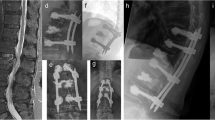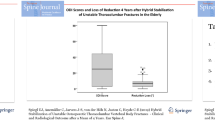Abstract
Purpose
Different treatment methods including immediate mobilization with or without brace, bed rest or immobilization using thoracolumbosacral orthosis have been applied for stable compression fractures of the pediatric spine. The aim of this study was to evaluate the influence of bracing on the remodeling capacity of pediatric thoracolumbar type A 1.2 impaction fractures. Additionally, the prevalence of pain and functional disabilities were assessed.
Methods
All children treated conservatively between 2000 and 2011 with impaction fractures of the thoracolumbar spine (A 1.2) were included and re-invited for a clinical [including VAS 0–100, Oswestry disability index (ODI)] and radiological follow-up examination. Changes of the sagittal index (SI) at the time of the accident, the latest control visit and at the follow-up examination were analyzed.
Results
Seventy-two patients with a mean age of 12 years (1.8–18 years) and a total number of 133 fractured vertebrae were included. The mean SI at the time of injury was 0.76 (range 0.45–0.94, SD 0.08); 34 patients with 67 fractured vertebrae were included in the follow-up examination after a mean of 7.9 years (2.4–13.1 years). The mean SI of the 67 affected vertebrae at follow-up significantly increased to 0.92 (range 0.74–1, SD 0.06). The initial treatment regimen (brace vs no brace) did not influence the remodeling capacity. More than half of the patients (n = 18, 53 %) complained about occasional back-related pain which was not associated with the remodeling process. The mean ODI was 5.8 (range 0–26, SD 6.6) and the mean VAS of the re-evaluated patients was 87 (range 53–100, SD 14).
Conclusions
A significant remodeling capacity of thoracolumbar vertebral impaction fractures sustained in childhood is demonstrated. Bracing does not seem to influence the long-term outcome of these injuries. More studies have to be performed to define the role of bracing in these fractures.






Similar content being viewed by others
References
Daniels AH, Sobel AD, Eberson CP (2013) Pediatric thoracolumbar spine trauma. J Am Acad Orthop Surg 21(12):707–716. doi:10.5435/JAAOS-21-12-707
Schalamon J, Dampf S, Singer G, Ainoedhofer H, Petnehazy T, Hoellwarth ME, Saxena AK (2011) Evaluation of fractures in children and adolescents in a Level I Trauma Center in Austria. J Trauma 71(2):E19–E25. doi:10.1097/TA.0b013e3181f8a903
Magerl F, Aebi M, Gertzbein SD, Harms J, Nazarian S (1994) A comprehensive classification of thoracic and lumbar injuries. Eur Spine J 3(4):184–201
Dogan S, Safavi-Abbasi S, Theodore N, Chang SW, Horn EM, Mariwalla NR, Rekate HL, Sonntag VK (2007) Thoracolumbar and sacral spinal injuries in children and adolescents: a review of 89 cases. J Neurosurg 106(6 Suppl):426–433. doi:10.3171/ped.2007.106.6.426
Rajasekaran S (2010) Thoracolumbar burst fractures without neurological deficit: the role for conservative treatment. Eur Spine J 19(Suppl 1):S40–S47. doi:10.1007/s00586-009-1122-6
Sawyer JR, Beebe M, Creek AT, Yantis M, Kelly DM, Warner WC Jr (2012) Age-related patterns of spine injury in children involved in all-terrain vehicle accidents. J Pediatr Orthop 32(5):435–439. doi:10.1097/BPO.0b013e318259f2b9
Karlsson MK, Moller A, Hasserius R, Besjakov J, Karlsson C, Ohlin A (2003) A modeling capacity of vertebral fractures exists during growth: an up-to-47-year follow-up. Spine 28(18):2087–2092. doi:10.1097/01.BRS.0000084680.76654.B1
Moller A, Hasserius R, Besjakov J, Ohlin A, Karlsson M (2006) Vertebral fractures in late adolescence: a 27 to 47-year follow-up. Eur Spine J 15(8):1247–1254. doi:10.1007/s00586-005-0043-2
Angelliaume A, Bouty A, Sales De Gauzy J, Vital JM, Gille O, Boissiere L, Tournier C, Aunoble S, Pontailler JR, Lefevre Y (2015) Post-trauma scoliosis after conservative treatment of thoracolumbar spinal fracture in children and adolescents: results in 48 patients. Eur Spine J. doi:10.1007/s00586-014-3744-6
Fairbank JC, Couper J, Davies JB, O’Brien JP (1980) The Oswestry low back pain disability questionnaire. Physiotherapy 66(8):271–273
Sayama C, Chen T, Trost G, Jea A (2014) A review of pediatric lumbar spine trauma. Neurosurg Focus 37(1):E6. doi:10.3171/2014.5.FOCUS1490
Santiago R, Guenther E, Carroll K, Junkins EP Jr (2006) The clinical presentation of pediatric thoracolumbar fractures. J Trauma 60(1):187–192. doi:10.1097/01.ta.0000200852.56822.77
Sledge JB, Allred D, Hyman J (2001) Use of magnetic resonance imaging in evaluating injuries to the pediatric thoracolumbar spine. J Pediatr Orthop 21(3):288–293
Gaca AM, Barnhart HX, Bisset GS 3rd (2010) Evaluation of wedging of lower thoracic and upper lumbar vertebral bodies in the pediatric population. AJR 194(2):516–520. doi:10.2214/AJR.09.3065
Lefevre Y, Journeau P, Angelliaume A, Bouty A, Dobremez E (2014) Proximal humerus fractures in children and adolescents. OTSR 100(1 Suppl):S149–S156. doi:10.1016/j.otsr.2013.06.010
Zimmermann R, Gschwentner M, Pechlaner S, Gabl M (2004) Remodeling capacity and functional outcome of palmarly versus dorsally displaced pediatric radius fractures in the distal one-third. Arch Orthop Trauma Surg 124(1):42–48. doi:10.1007/s00402-003-0552-6
Parisini P, Di Silvestre M, Greggi T (2002) Treatment of spinal fractures in children and adolescents: long-term results in 44 patients. Spine 27(18):1989–1994
Rathleff MS, Roos EM, Olesen JL, Rasmussen S (2013) High prevalence of daily and multi-site pain—a cross-sectional population-based study among 3000 Danish adolescents. BMC pediatrics 13:191. doi:10.1186/1471-2431-13-191
Author information
Authors and Affiliations
Corresponding author
Ethics declarations
Conflict of interest
None.
Rights and permissions
About this article
Cite this article
Singer, G., Parzer, S., Castellani, C. et al. The influence of brace immobilization on the remodeling potential of thoracolumbar impaction fractures in children and adolescents. Eur Spine J 25, 607–613 (2016). https://doi.org/10.1007/s00586-015-4250-1
Received:
Revised:
Accepted:
Published:
Issue Date:
DOI: https://doi.org/10.1007/s00586-015-4250-1




